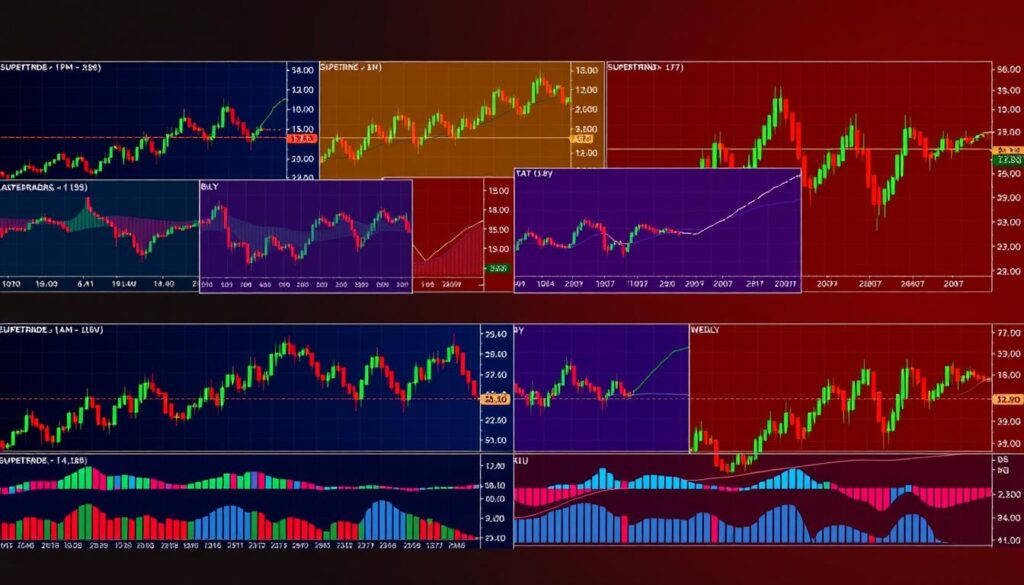The Supertrend indicator is a technical analysis tool designed to help investors identify market trends. Developed by Olivier Seban in 2009, it has quickly become a staple in many trading arsenals due to its simplicity and effectiveness in a trading strategy. This indicator combines elements of moving averages and volatility to generate signals, making it a valuable tool for technical analysis.
The Supertrend indicator uses the average true range (ATR) and a multiplier to plot a line above or below the price action, providing a clear visual representation of market trends. With its ability to identify trends and provide buy and sell signals, the Supertrend indicator has become a popular choice among traders looking to enhance their trading performance with a solid trading strategy.
By utilizing the Supertrend indicator in their technical analysis, traders can make more informed decisions and improve their overall trading strategy. Whether you’re a seasoned trader or just starting out, the Supertrend indicator is a valuable tool to have in your arsenal, especially when combined with other technical analysis tools for confirmation.
Table of Contents
Key Takeaways
- The Supertrend indicator is a technical analysis tool used to identify market trends.
- It combines elements of moving averages and volatility to generate signals, aiding in a trading strategy.
- The indicator uses the average true range (ATR) and a multiplier to plot a line above or below the price action.
- Typical default values for the Supertrend indicator include an ATR of 7 to 13 trading sessions and a multiplier of 3, which can be adjusted to suit a trading strategy.
- The Supertrend indicator is known for its simplicity and effective trend identification, making it a valuable tool for technical analysis.
- A stop loss can be placed at the Supertrend line for risk management, and it’s more effective in clear trending markets when used with other technical analysis tools for confirmation.
- The Supertrend indicator provides quick technical analysis, aiding intraday traders in making faster decisions with a trading strategy.
Understanding the Supertrend Indicator in Trading
The Supertrend indicator is a trend following indicator that provides clear buy and sell signals based on an asset’s price action and volatility measure. It combines elements of moving averages and average true range (ATR) to generate its signals.
This indicator is particularly useful for traders who want to capitalize on trending markets. By adjusting the average true range (ATR) and multiplier, traders can make the indicator more or less sensitive to current price action.
What is the Supertrend Indicator?
The Supertrend indicator is based on a single line overlaid onto a market’s chart that changes color to signal bullish or bearish market conditions. It generates buy and sell signals when the line crosses the market’s price and the color switches.
Core Components of Supertrend
The Supertrend indicator works using two inputs: an average true range (ATR) and a multiplier. The standard settings are an ATR of 10 sessions and a multiplier of three, but traders can adjust these settings based on their trading strategy and style.
Historical Development and Evolution
The Supertrend indicator has evolved over time to become a reliable tool for traders. Its ability to measure volatility using the average true range (ATR) makes it a valuable trend following indicator for traders of all levels.
The Mathematics Behind Supertrend Calculations
The Supertrend indicator is based on a Supertrend formula that involves calculating the Average True Range (ATR) and the upper and lower bands. The ATR calculation is a crucial component of the Supertrend formula, as it helps to determine the volatility of the market. The ATR formula is: ATR = (Previous ATR x (n – 1) + TR) / n.
The upper and lower bands are calculated using the following formulas: Upperband = (High + Low) / 2 + (Multiplier x ATR) and Lowerband = (High + Low) / 2 – (Multiplier x ATR). These bands are used to determine the trend direction and potential buy or sell signals.
Here is a summary of the Supertrend calculations:
- ATR calculation: ATR = (Previous ATR x (n – 1) + TR) / n
- Upper band calculation: Upperband = (High + Low) / 2 + (Multiplier x ATR)
- Lower band calculation: Lowerband = (High + Low) / 2 – (Multiplier x ATR)
Understanding the Supertrend formula and the ATR calculation is essential for using the Supertrend indicator effectively in trading. By grasping the mathematics behind the Supertrend calculations, traders can better interpret the signals generated by the indicator and make more informed trading decisions.
Setting Up the Supertrend Indicator on Your Trading Platform
To get started with the Supertrend indicator, you’ll need to set it up on your trading platform. This involves installing the indicator, configuring its basic parameters, and customizing its visual settings to suit your preferences. The standard default values for the Supertrend indicator are an ATR of between seven and 13 trading sessions and a multiplier of three.
When it comes to trading platforms, the Supertrend indicator can be integrated into various platforms like MetaTrader, TradingView, and NinjaTrader. Each platform may have slightly different indicator settings, so it’s essential to consult the platform’s documentation for specific instructions. Additionally, customization options may vary, allowing you to personalize the indicator’s appearance and behavior.
Here are some general steps to follow when setting up the Supertrend indicator on your trading platform:
- Install the Supertrend indicator on your platform, if it’s not already available.
- Configure the basic parameters, such as the ATR period and multiplier.
- Customize the visual settings, such as the color and style of the indicator lines.
By following these steps and experimenting with different indicator settings and customization options, you can optimize the Supertrend indicator for your trading strategy and trading platforms.
| Platform | Default ATR | Default Multiplier |
|---|---|---|
| MetaTrader | 10 | 3 |
| TradingView | 7 | 3 |
| NinjaTrader | 13 | 3 |
Key Parameters and Their Impact on Trading Signals
The Supertrend indicator’s effectiveness relies heavily on its key parameters: ATR period and multiplier. Adjusting these parameters affects the sensitivity of the indicator, making it more or less reactive to price movements. A shorter ATR period and smaller multiplier make the indicator more sensitive, creating more signals, which is ideal for day traders seeking frequent trading opportunities.
A longer ATR period and larger multiplier, on the other hand, make the indicator less sensitive, resulting in fewer signals. This setting is more suitable for longer-term traders who prioritize stable trend identification over frequent trading signals. The sensitivity adjustment of the Supertrend indicator is crucial in finding the right balance for your trading style.
Common settings for the Supertrend indicator include an ATR period of 10 or 14 days and a multiplier of 3. However, traders can experiment with different combinations to find the optimal setting for their strategy. For example, an aggressive setting with an ATR period of 7 and a multiplier of 2 can be used for short-term traders, while a conservative setting with an ATR period of 14 and a multiplier of 4 can be used for long-term traders.
Understanding how to adjust the ATR period and multiplier is essential in using the Supertrend indicator effectively. By finding the right balance between sensitivity and reliability, traders can maximize the potential of this powerful trading tool and make informed decisions based on the ATR period and multiplier settings.
Reading and Interpreting Supertrend Signals
When it comes to trading, accurately reading and interpreting Supertrend signals is crucial for making informed decisions. The Supertrend indicator is a powerful tool that provides buy and sell signals, helping traders to identify trend reversals and potential trading opportunities. By understanding the significance of the indicator’s color changes and line positions relative to price, traders can make more accurate predictions and minimize losses.
The Supertrend line moves below the price to generate buy signals, and when it moves above the price, it’s generally a sign to sell. The indicator turns green in an uptrend, indicating a potential buying opportunity, and turns red in a downtrend, signaling a potential selling opportunity. Traders should look for confirmation signals, such as a breakout above the Supertrend line, to validate buy signals, and a breakdown below the Supertrend line to confirm sell signals.
Bullish and Bearish Signals
To identify bullish and bearish signals, traders should monitor the Supertrend line and price action. A bullish signal is generated when the Supertrend line moves below the price, indicating a potential uptrend. On the other hand, a bearish signal is generated when the Supertrend line moves above the price, indicating a potential downtrend. By combining the Supertrend indicator with other technical indicators, such as moving averages or RSI, traders can increase the accuracy of their trading decisions.
Confirmation Signals and Trend Reversal
Confirmation signals are essential to validate buy and sell signals. Traders should look for additional indicators, such as moving averages or RSI, to confirm the trend reversal. A trend reversal occurs when the Supertrend line changes direction, indicating a potential change in the market trend. By identifying trend reversals and confirmation signals, traders can make more informed decisions and maximize their trading profits. Effective use of the Supertrend indicator requires a combination of technical analysis and risk management strategies, including setting stop-loss orders to minimize losses.
Common Trading Strategies Using Supertrend
The Supertrend indicator is a valuable tool for traders, offering insights into market trends and potential trading opportunities. When it comes to trend following, the Supertrend indicator can help traders identify and capitalize on emerging trends. By combining the Supertrend indicator with other technical analysis tools, traders can develop a robust trading strategy that incorporates breakout trading and swing trading techniques.
Some traders prefer to use the Supertrend indicator as a standalone tool, while others combine it with moving averages or other indicators to filter out market noise and identify trend status. The Supertrend indicator can be used in various trading scenarios, including day trading and swing trading, with rules set for directional trading based on longer-term trend signals and incorporating stop-loss measures.
Traders can adjust the period setting and factor setting to customize the Supertrend indicator for their trading strategy. For example, a setting of 10 and 3 can be used for swing trading, while a setting of 30 and 9 can be used for longer-term trend analysis. By combining the Supertrend indicator with other technical analysis tools and adjusting the settings to suit their trading style, traders can develop a trading strategy that incorporates trend following and breakout trading techniques.
Combining Supertrend with Other Technical Indicators
The Supertrend indicator can be more reliable when used with other technical indicators like moving averages or the relative strength index (RSI) for signal confirmation. This approach is part of creating a robust trading system that minimizes false signals and maximizes trading opportunities.
One effective way to combine Supertrend with other indicators is by using indicator combinations such as Supertrend with Moving Averages or Supertrend with RSI. These combinations can provide more accurate buy and sell signals, helping traders make informed decisions.
For example, combining Supertrend with MACD can help identify trend changes and confirm trading signals. The MACD indicator combines a slow moving average of 26 periods and a fast moving average of 12 periods, with a 9-period moving average signal line. This combination can be used to generate buy and sell signals based on crossovers, providing a clear and simple trading strategy.
The Supertrend indicator integrates the ATR volatility indicator, using a 10-period ATR length and a Supertrend factor of 3.0 for trend identification. By combining this with other indicators, traders can create a comprehensive trading system that captures trending markets efficiently and minimizes drawdowns.
| Indicator Combination | Description |
|---|---|
| Supertrend with Moving Averages | Uses moving averages to confirm Supertrend signals |
| Supertrend with RSI | Combines Supertrend with RSI to identify overbought and oversold conditions |
| Supertrend with MACD | Uses MACD crossovers to confirm Supertrend signals |
By experimenting with different indicator combinations and trading systems, traders can find the approach that works best for them and improve their overall trading performance with accurate signal confirmation.
Risk Management When Trading with Supertrend
Effective risk management is crucial when trading with the Supertrend indicator. This involves careful consideration of stop-loss placement, position sizing, and the risk-reward ratio. A well-placed stop loss can help limit losses, while a suitable position size can ensure that the trade does not overly expose the trading account to risk.
A common approach to stop-loss placement is to set the stop loss at a level that is a certain percentage below the entry price. For example, a 1% stop loss can be set below the entry price for long positions. The risk-reward ratio is also an essential consideration, as it determines the potential profit relative to the potential loss. A favorable risk-reward ratio can help traders achieve their investment goals while managing risk.
Here are some key considerations for risk management when trading with Supertrend:
- Set a stop loss at a level that is a certain percentage below the entry price
- Use a suitable position size to manage risk
- Aim for a favorable risk-reward ratio to achieve investment goals
By carefully managing risk and using the Supertrend indicator effectively, traders can increase their chances of success in the markets. It is essential to remember that risk management is an ongoing process that requires continuous monitoring and adjustment.
| Risk Management Strategy | Description |
|---|---|
| Stop-Loss Placement | Set a stop loss at a level that is a certain percentage below the entry price |
| Position Sizing | Use a suitable position size to manage risk |
| Risk-Reward Ratio | Aim for a favorable risk-reward ratio to achieve investment goals |
Best Timeframes for Supertrend Analysis
When it comes to using the Supertrend indicator, choosing the right timeframe is crucial for effective trading. The Supertrend indicator can be applied to various timeframes, making it a versatile tool for intraday trading, swing trading, and long-term investing. For intraday trading, a shorter timeframe such as 10 minutes can be used, while for swing trading and long-term investing, longer timeframes such as daily or weekly charts can be more suitable.
The key to successful Supertrend analysis is to match the timeframe with your trading goals and risk tolerance. For example, if you’re an intraday trader, you may want to focus on shorter timeframes to capture quick price movements. On the other hand, if you’re a long-term investor, you may want to use longer timeframes to ride out market fluctuations.
- 10-minute chart for intraday trading
- 1-hour chart for short-term swing trading
- Daily chart for medium-term investing
- Weekly chart for long-term investing
Ultimately, the best timeframe for Supertrend analysis will depend on your individual trading strategy and goals. By experimenting with different timeframes and adjusting your strategy accordingly, you can optimize your use of the Supertrend indicator and improve your trading results.
Avoiding Common Mistakes with Supertrend Trading
When using the Supertrend indicator, it’s essential to be aware of common pitfalls that can impact trading performance. One of the primary concerns is the generation of false signals, particularly in sideways or “choppy” markets. This can lead to incorrect trading decisions, affecting overall risk management. To mitigate this, traders must develop a solid understanding of trading psychology, recognizing the importance of patience and discipline in navigating uncertain market conditions.
To avoid signal misinterpretation, traders should consider combining the Supertrend indicator with other technical indicators, such as Moving Averages or the Relative Strength Index (RSI). This can help confirm trading signals and reduce the likelihood of false positives. Additionally, proper position sizing is crucial to managing risk and protecting against significant losses. By adopting a holistic approach to trading, incorporating both technical analysis and sound risk management principles, traders can minimize mistakes and optimize their use of the Supertrend indicator.
Some key strategies for avoiding common mistakes with Supertrend trading include:
- Regularly reviewing and adjusting trading parameters to adapt to changing market conditions
- Implementing a robust risk management plan, including stop-loss orders and position sizing
- Cultivating a deep understanding of trading psychology to inform trading decisions and avoid impulsive actions
Advanced Supertrend Trading Techniques
For experienced traders looking to elevate their Supertrend trading, advanced techniques such as multi-timeframe analysis can be invaluable. This approach involves analyzing trends across different timeframes to confirm the strength and direction of a trend. By doing so, traders can make more informed decisions and reduce the risk of false signals.
Another advanced technique is divergence trading, which involves identifying discrepancies between the Supertrend indicator and the price action. This can be a powerful tool for predicting potential reversals and staying ahead of the market. Additionally, trend strength assessment is crucial for determining the reliability of a trend and making informed trading decisions.
To incorporate these advanced techniques into their trading, traders can start by experimenting with different timeframes and analyzing the relationships between them. They can also explore various trend strength assessment methods, such as using the Average Directional Index (ADX), to gain a deeper understanding of market trends.
Some key considerations for advanced Supertrend trading include:
- Using a combination of short-term and long-term timeframes for multi-timeframe analysis
- Implementing divergence trading strategies to identify potential reversals
- Regularly assessing trend strength to adjust trading decisions
Backtesting Your Supertrend Strategy
To refine your Supertrend strategy, it’s essential to backtest it using historical data. This process involves analyzing performance metrics, such as annualized return and volatility, to evaluate the strategy’s effectiveness. By examining the results, you can identify areas for improvement and refine your strategy to optimize its performance.
A key aspect of backtesting is developing a robust testing framework. This includes defining the parameters for the Supertrend calculation, such as the length and multiplier, and determining the criteria for trade entry and exit. By using historical data, you can simulate trades and analyze the results to refine your strategy.
When analyzing the results, consider the following factors:
- Annualized return: The Supertrend strategy achieved an annualized return of 25.88%.
- Volatility: The strategy had a relatively low annualized volatility of around 13%.
- Sharpe ratio: The strategy’s Sharpe ratio was 1.84, indicating a strong risk-adjusted return.
By refining your strategy based on historical data and performance metrics, you can improve its effectiveness and increase your confidence in its ability to generate profitable trades. This process of strategy refinement is ongoing, and it’s essential to continually monitor and adjust your strategy to ensure it remains optimal.
Real-World Examples of Successful Supertrend Trading
The Supertrend indicator has been successfully applied in various market scenarios, demonstrating its effectiveness in identifying trends and managing risk. Through case studies, we can analyze the decision-making process of experienced traders and gain insights into their strategies.
A key aspect of successful Supertrend trading is the ability to adapt to changing market scenarios. By adjusting the indicator’s parameters, such as the ATR period and multiplier, traders can fine-tune their strategy to suit different market conditions. Trade analysis plays a crucial role in this process, as it enables traders to evaluate their performance and make data-driven decisions.
Some notable examples of successful Supertrend trading include:
- Using the 4-hour timeframe on mainstream exchanges like Coinbase Pro
- Applying a risk-reward ratio of 0.75 to calculate the first take profit level
- Optimizing the Supertrend indicator’s parameters to suit individual trading styles and risk appetites
By examining these examples and conducting thorough trade analysis, traders can develop a deeper understanding of the Supertrend indicator’s capabilities and limitations. This knowledge can be used to inform their case studies and improve their overall trading performance in various market scenarios.
| Parameter | Value |
|---|---|
| ATR Period | 14 bars |
| Supertrend Multiplier | 2.5 |
| Risk-Reward Ratio | 0.75 |
Conclusion
As we conclude this comprehensive guide on the Supertrend indicator, it’s important to remember that successful trading is a journey of continuous learning and adaptation. The Supertrend indicator is a powerful tool that can provide valuable insights into market trends, but it should be used in conjunction with other technical analysis techniques and a well-structured risk management plan. By incorporating the Supertrend indicator into your trading strategies and constantly refining your approach, you can increase your chances of trading success and navigate the ever-changing market landscapes. Remember, the key is to remain diligent, curious, and open to continuous learning as you strive to become a more proficient trader. With practice and a willingness to adapt your strategies to market adaptation, the Supertrend indicator can be a valuable ally in your quest for consistent profitability.
FAQ
What is the Supertrend Indicator?
The Supertrend Indicator is a popular trend-following tool used by traders to identify the direction and strength of market trends. It utilizes the Average True Range (ATR) to establish dynamic upper and lower bands that act as support and resistance levels.
What are the core components of the Supertrend Indicator?
The core components of the Supertrend Indicator include the Average True Range (ATR) and the multiplier, which determine the sensitivity and responsiveness of the indicator to price movements.
How has the Supertrend Indicator evolved over time?
The Supertrend Indicator has evolved to adapt to modern trading environments, with adjustments and refinements made to its calculations and parameters to improve its performance and applicability across different asset classes and market conditions.
How do I set up the Supertrend Indicator on my trading platform?
Setting up the Supertrend Indicator on your trading platform typically involves installing the indicator, configuring the basic parameters such as the ATR period and multiplier, and customizing the visual settings to suit your preferences.
How do the key parameters of the Supertrend Indicator affect trading signals?
Adjusting the ATR period and multiplier can significantly impact the sensitivity of the Supertrend Indicator, making it more or less responsive to price movements. Finding the right balance of these parameters is crucial for aligning the indicator with your trading style and risk tolerance.
How do I accurately read and interpret Supertrend signals?
Accurately reading and interpreting Supertrend signals involves understanding the significance of the indicator’s color changes and line positions relative to the price. Identifying bullish and bearish signals, as well as potential trend reversals, is key to effectively using the Supertrend Indicator.
What are some common trading strategies that incorporate the Supertrend Indicator?
The Supertrend Indicator can be incorporated into various trading strategies, including trend-following approaches, breakout trading techniques, and swing trading methods. Combining these strategies with proper risk management is essential for successful Supertrend-based trading.
How can I enhance the Supertrend Indicator’s effectiveness by combining it with other technical indicators?
Combining the Supertrend Indicator with other popular technical indicators, such as moving averages, RSI, and MACD, can provide more robust trading signals and greater confirmation of market trends. However, it’s important to avoid indicator redundancy and information overload.
How do I properly manage risk when using the Supertrend Indicator?
Effective risk management when using the Supertrend Indicator involves strategies such as optimal stop-loss placement, effective position sizing, and maintaining a favorable risk-reward ratio. Preserving capital and managing emotions are crucial components of successful Supertrend-based trading.
What are the most effective timeframes for using the Supertrend Indicator?
The Supertrend Indicator can be applied across various timeframes, from short-term intraday trading to longer-term swing trading and investing. The most appropriate timeframe depends on your trading goals, risk tolerance, and the available time you have for market analysis.
What are some common pitfalls to avoid when using the Supertrend Indicator?
Common pitfalls when using the Supertrend Indicator include signal misinterpretation, over-reliance on a single indicator, and poor position sizing. Addressing these challenges through continuous learning and adaptation is crucial for successful Supertrend-based trading.
What are some advanced techniques for experienced traders using the Supertrend Indicator?
Advanced Supertrend trading techniques include multi-timeframe analysis, divergence trading, and methods for assessing trend strength. Incorporating these techniques into your trading strategy can help take your Supertrend-based trading to the next level, but they require thorough testing and practice before application.
How do I effectively backtest my Supertrend-based trading strategies?
Backtesting your Supertrend-based trading strategies involves developing a robust testing framework, analyzing the results objectively, and optimizing your strategies based on historical performance. This process is essential for refining your trading approach and improving your chances of success.
Can you provide real-world examples of successful trades using the Supertrend Indicator?
Analyzing specific market scenarios and case studies where the Supertrend Indicator was effectively applied can provide valuable insights into the decision-making process of experienced traders. These real-world examples can help bridge the gap between theoretical knowledge and practical application.









